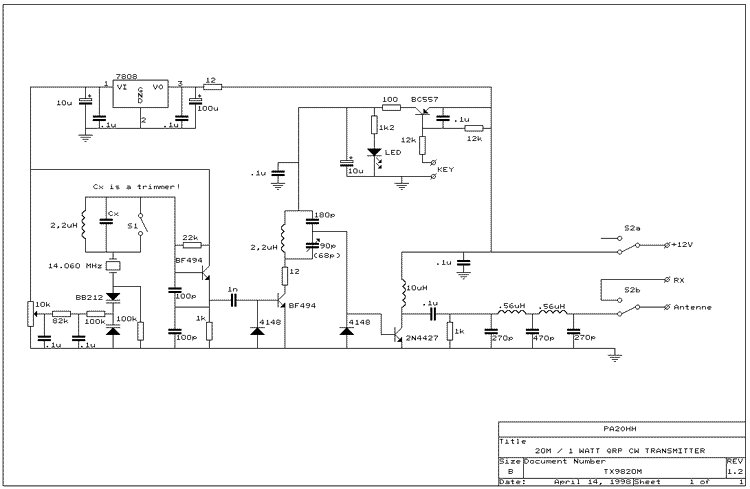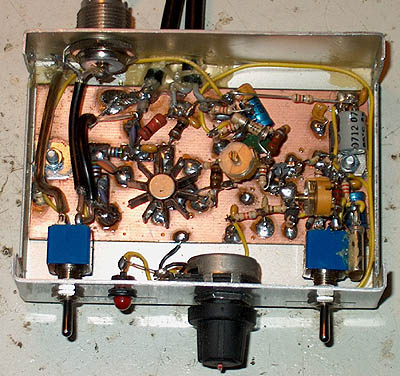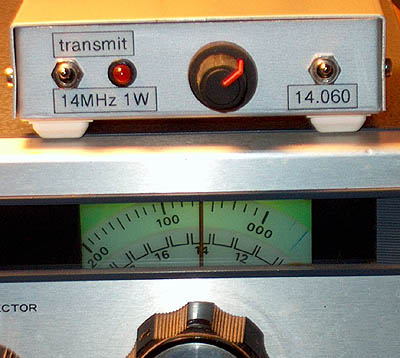
The 1 watt QRP transmitter with VXO.
Good for many QSO's!
QRP TRANSMITTER WITH VXO
(1998)
KLIK HIER VOOR DE NEDERLANDSE VERSIE

The 1 watt QRP transmitter with VXO.
Good for many QSO's!
What you can do with such a simple 1 watt QRP power transmitter.
This is a real low power transmitter, so do not expect that you can do everything with it but...
When conditions are normal, you can easily make many QSO's during one afternoon with stations with distances upto 2000 km with a simple inverted V wire dipole antenna! From Europe, I did even make QSO's across the Ocean!
Schematic diagram

Circuit diagram
big diagram
VXO
Here, a varicap diode is used for tuning the VXO, but of course you can replace it by a variable capacitor of 100-200 pF. The voltage stabilizer circuit with a 7808 can be deleted, the VXO is supplied from the 12V.
A parallel circuit of Lx (2,2 uH) and a trimmer Cx is added in series with the X-tal to increase the VXO range. Doing some experiments with Cx is very interesting: When starting at minimun capacitance, the frequency goes down when increasing the capacitance. At a certain moment the oscillator stops (resonance of Lx // Cx) or jumps a few MHz down, then it suddenly starts to oscillate at a frequency that is above the crystal frequency. When increasing the capacitance further the oscillator frequency goes down. The trimmer Cx is adjusted so that there is no gap between both frequency ranges (switchable with S1).
However, the VXO range is very dependent on the used crystal. I had good results with cheap computer crystals (even 150 kHz or so) and a very bad result with a high quality crystal (only 2 kHz). Stability reduces considerably when tuning further from the crystal frequency. At a few hundred kHz from the crystal frequency, the stability is more or less the same as that of a VFO... Many amateurs have very good results with VXO's so do not give up if the first results are bad.
Buffering and driver
An extra driver/buffer stage is added between the VXO and the final stage. Due to this driver/buffer stage, the VXO stability is less influenced by feedback from the final amplifier when tuning antenna's etc. When trying to make a VXO with a large frequency range with my first QRP transmitter without buffering, stations reported that my frequency was not stable.
The VXO is a low power oscillator to prevent high RF voltages across the varicap diode. This would also decrease the stability considerably. The driver/buffer stage has also the task to make sufficient driving power for the 1 watt final amplifier. The 12 ohm resistors are added to avoid parasitic oscillations.
| Tuning ranges, crystal frequency 14060 kHz | |||
| Position S1 | Minimum Frequency (kHz) |
Maximum Frequency (kHz) |
Range (kHz) |
| Open (Lx // Cx active) | 14047.0 | 14058.7 | 11.7 |
| Closed (Lx // Cx shortened) | 14058.7 | 14063.0 | 4.3 |
| Total (open + closed) | 14047.0 | 14063.0 | 16.0 |
The final RF amplifier
The 2N4427 transistor is doing the heavy work here but you can also use others like a 2N3553. The 1000 ohm resistor at the input of the low pass filter is added to avoid high peak voltages during mismatches of the antenna.

Inside.
PERFORMANCE

Used together with an old SSR1 shortwave receiver.